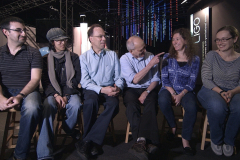
Yesterday, August 25 saw the passing of MIT Professor Emeritus Rainer Weiss, co-designer of LIGO, the gravitational wave observatory, renowned experimental physicist, and Nobel laureate. As noted in an article by MIT, “During his remarkable career, Weiss developed a more precise atomic clock and figured out how to measure the spectrum of the cosmic microwave background via a weather balloon. He later co-founded and advanced the NASA Cosmic Background Explorer project, whose measurements helped support the Big Bang theory describing the expansion of the universe.”
I first met Rainer in 2014 when working on my second film for LIGO and the National Science Foundation, “LIGO Generations”. I was immediately aware of his keen focus on our conversation, someone not distracted by a cell phone or computer. He welcomed me into his office, and gave me his full attention for the duration of our first interview. We spent time together kayaking (with Nergis Mavalvala) and in the basement of the physics lab where Rainer drew a simple diagram of a complex subject—the means by which a laser interferometer captures the passing of a gravitational wave.
 Rai was always teaching. He never tired of sharing a physics explanation for otherwise mundane things, the separation of water droplets as they fall from a faucet, the colors of a rainbow, or noise filters in hi-fi audio. At one of the annual LIGO Scientific Collaboration gatherings he shared with me the frequency curve in which the detectors operate, and how the teams were working to improve the sensitivity in order to observe more distant and less massive mergers. I will keep his sketches for as long as I am yet on this Earth as a bold reminder that teaching and learning are two of the most fundamental things we as humans share, and they are almost always best when done in person, hands waving, eyes connecting, stylus on paper.
Rai was always teaching. He never tired of sharing a physics explanation for otherwise mundane things, the separation of water droplets as they fall from a faucet, the colors of a rainbow, or noise filters in hi-fi audio. At one of the annual LIGO Scientific Collaboration gatherings he shared with me the frequency curve in which the detectors operate, and how the teams were working to improve the sensitivity in order to observe more distant and less massive mergers. I will keep his sketches for as long as I am yet on this Earth as a bold reminder that teaching and learning are two of the most fundamental things we as humans share, and they are almost always best when done in person, hands waving, eyes connecting, stylus on paper.
While I did not spend nearly as much time with Rai as did his colleagues and students, I find myself looking through photos and stills, watching sections of my films about LIGO, and reading the emails he and I exchanged as recently as November last year. In the context of a world too quickly embracing artificial intelligence, I embrace the stunning beauty of an authentically intelligent human being, and am reminded of what the human brain is capable of doing when given time to solve problems. My life was enriched through our brief interactions. Certainly, hundreds more to a similar or greater degree. Rainer Weiss moved an entire generation of curious minds to see the universe in a whole new way.
Stories about Rainer Weiss: MIT | New York Times | SCIENCE
LIGO, A Passion for Understanding | LIGO Generations | LIGO Detection


